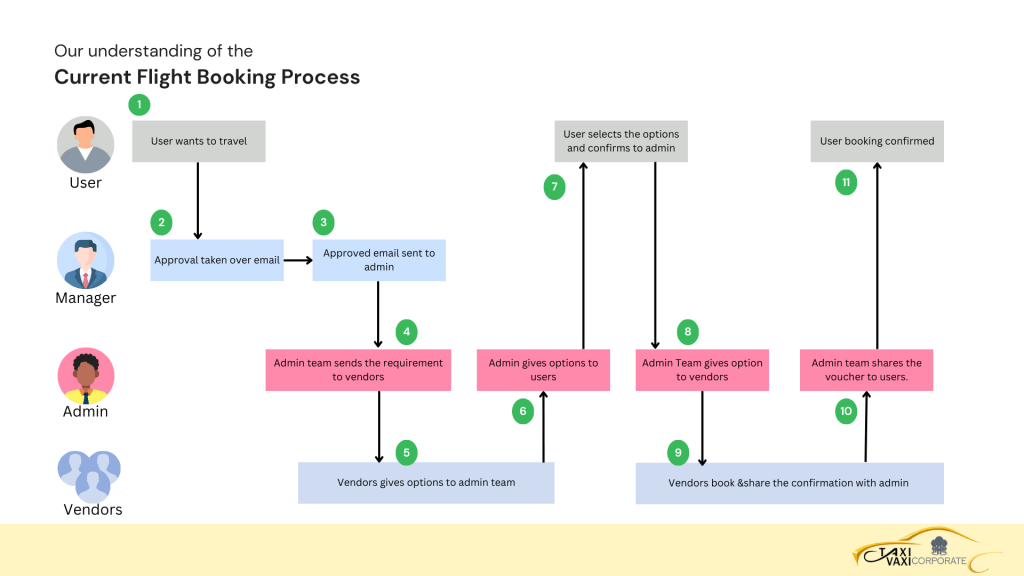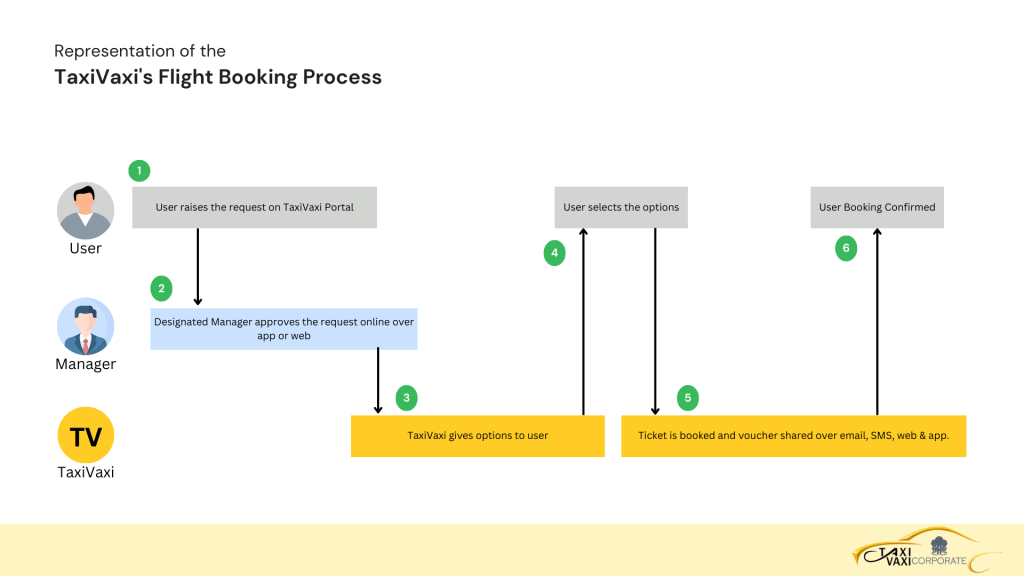Have you ever found yourself juggling emails, calls, and spreadsheets just to book a single flight for an employee? What if there was a way to make this cumbersome process more efficient and user-friendly? Here is the detailed flight booking process flowchart, from basic to innovative.
In today’s fast-paced business environment, the convenience of booking flights efficiently can be a game-changer. This blog aims to shed light on two types of flight booking processes: the conventional method and the TaxiVaxi way. Let’s dive in.
Understanding the Conventional Flight Booking Process

Ever wondered how many steps it actually takes to finalize a flight booking? Although it may appear simple at first glance, for those managing these bookings, it can be a long and complex maze. Let’s break down the conventional process step-by-step.
- Employee’s Travel Need: An employee identifies the need for travel and initiates the process.
- Manager’s Approval: The employee sends an email to their manager for travel approval.
- Admin Involvement: Once approved, the email is forwarded to the admin team.
- Vendor Coordination: The admin team reaches out to multiple vendors for flight options.
- Options Returned: Vendors provide various flight options back to the admin.
- Employee’s Selection: The admin team presents these options to the employee.
- Secondary Approval: If the chosen flight is not the cheapest option, secondary approval is required from the manager.
- Finalizing the Choice: After all approvals, the admin team forwards the selection to the vendor.
- Vendor Booking: The vendor books the flight and sends a confirmation to the admin.
- Voucher Sharing: Finally, the admin team shares the travel voucher with the employee.
- Booking Confirmed: The employee’s flight booking is confirmed.
Does this process seem too long and cumbersome for a task as simple as flight booking? Imagine doing this regularly for multiple employees. What if there was an easier way?
Introducing TaxiVaxi’s Streamlined Flight Booking Process

Curious to find out how technology can simplify this convoluted process? TaxiVaxi presents a streamlined alternative that cuts down on the steps and stakeholders involved, saving your company both time and resources. TaxiVaxi provides a more efficient flight booking process flowchart by reducing the steps and number of people involved, helping your business save time and money.
Here’s how TaxiVaxi changes the game:
- Employee’s Direct Request: Through the TaxiVaxi app or web portal, an employee can directly raise a travel request. No back-and-forth emails are needed!
- Instant Manager Approval: Designated managers can instantly approve the request through the same platform.
- Automated Options: TaxiVaxi then provides an array of flight options to the employee.
- One-Click Selection: The employee selects the preferred option right from the app or web portal.
- Immediate Booking: Once selected, the ticket is booked, and the voucher is shared via email, SMS, the web, and the app.
- Instant Confirmation: Just like that, the booking is confirmed. No waiting, no unnecessary emails.
And there you have it! Six simple steps involving just three stakeholders: the employee, the manager, and TaxiVaxi
Could it get any simpler? Do you still want to stick with the conventional, 11-step process? Or are you ready to revolutionize your company’s approach to flight booking?
Takeaway: Make The Right Choice
In conclusion, the differences between the conventional and TaxiVaxi methods of flight booking have become evident.
If you’re a travel manager or HR admin tasked with coordinating employee travel, you must be asking, “Isn’t there a more efficient way to do this?” Through the flight booking process flowchart, you might compare how TaxiVaxi reduces the 11-step process to a simple six-step process with fewer human resources involved.
Time is money, especially in business. The TaxiVaxi way could save hours, if not days, in back-and-forths, waiting for approvals, and comparing vendor options.
Not only does TaxiVaxi streamline the booking process, but it also reduces the chances of errors, missed communications, and delays.



![Read more about the article Pack like a pro with this business trip packing list [Downloadable checklist PDF included]](https://taxivaxi.com/wp-content/uploads/2023/08/Business-Trip-Packing-Checklist-300x169.png)
